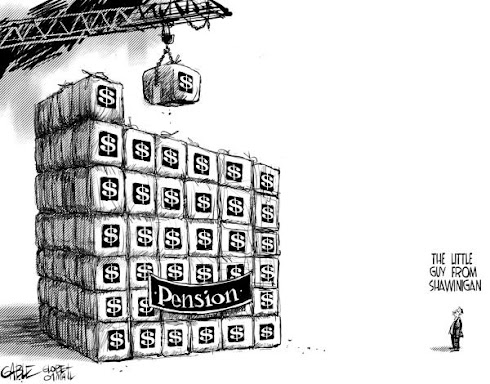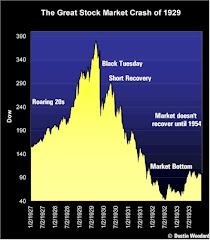
Today there was coverage about the BC Supplementary Pension Plan in the Globe. Pensions at Meech
More Pensions for All
This will be another issue that has the potential to divert the media and politicians away from the issue of the public sector gold-plated pensions. While I hold some hope in the new supplementary plans, they will be only good if they fund at the same levels for private sector workers as they fund for public sector employees.
Part of the problem is the huge contributions required to fund pensions to the level of the public sector plans. About 30% of payroll is needed. For example, the BC teachers pay about 9% into the plan to get a $41,000 pension. A self employed person pays 9.9% into CPP to get a $10,800 pension. It is the taxpayer who picks up the rest in the public employee plan.
Let's fund both the private and public sector employee plans at the same rates. Why should the taxpayer have to pick up the tab for the gold-plated public employee pension plan?
In the CD Howe report Supplementary Pensions the design of the plan is presented by Ambachtsheer. He is one of the world's foremost pension experts. Another CD Howe report
A Pension in Every Pot discusses the problem of inadequate pensions for most Canadians. This is part of the BC supplementary plan issue.
These supplementary plans will not solve the issue of taxpayer funded public sector plans.
It may be too late to do anything about these public sector pension plans. Statscan estimates the value of BC's infrastructure at $40.9 billion. We have seen the value of the public sector plans in BC Pension Plans well in excess of this amount. This means that in the past 30 years. BC taxpayers have funded more into the gold-plated pension plans that into all of BC's infrastructure. Value of BC's Infrastructure
So part of the problem now becomes where do these pension plans invest their money? As you know they purchase stocks and bonds. The latest bandwagon is Private Public Partnerships PPP's. This becomes dangerous when public employee pension plans own the country's infrastructure. They love to invest best into areas where they have a monopoly and where they can get a high rate of return.
Check out the Ontario Teachers holdings.
They love monopoly investments. For example, the 407 toll road in Ontario. The most expensive in the world. Who pays the costs of traveling on the road? Is it a monopoly? Is the road beneficial for Ontario taxpayers or just the public pension plans that own the highway?
They recently updated their web site but had advertised the beauty of Private Capital is that they can get a 20% to 25% return. Bell Canada was a good example of the type of investments they like.
OTPP Holdings:
* Port facilities - OTPP owns the ports of Vanterm and Deltaport in Vancouver.
* A major portion of Chile's water and sewage systems
* UK airports
It may be worth the cost of the supplementary pans if we can stop funding into public employee pension funds. For example, at Y/E 2007 the OTPP had $110B and the value of Ontario's infrastructure was $ 90B. The OTPP is just one of several Ontario public sector pensions, much like BC.
These pension plans are already larger than the infrastructure of their provinces. They will soon own the infrastructure in most provinces. The plans are controlled by public sector employees. Whose interests will they protect? Those of their pension plan members or those of the taxpayers? The public sector used to be called the public service, but now the servants have become the masters (sounds like the Sting concert I was at last week).
The way I see it these things cannot avoid being a disaster whatever happens. They will by their very nature have to own most of the economic resources of the country. Peter Drucker had been talking about the socialism of pensions since the 1970's. It looks like these prophesies are bound to come true.




